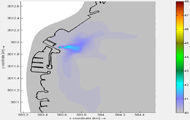3D Hydrodynamic and Dispersion Numerical Model Study
|
HRI has a wide experience in hydraulic modeling for coastal and river projects which include but not limited to the following:
Coastal Engineering Problems: Hydrodynamic studies River Engineering Problems:HRI has comprehensive software systems available for Modeling flows and flow dependant processes in a river network and its associated floodplains. The river projects that have been simulated with the available models include but not limited to the following: The Modeling capabilities of HRI include:
1-Hydraulic structures operation and management. Industrial Engineering (Pipeline):HRI has capabilities in modeling the transient flow through the pipeline. Delft-3D:It is a fully-integrated process-based two or three-dimensional compound modeling system. The model package consists of four modules which controls with the main module. The four modules are wave (HISWA), flow, transport and bottom modules. It simulates the flows, waves, sediments, morphological developments and water quality aspects. HISWA wave module is a model to be used for the simulation of wave generation, propagation and dissipation in coastal areas. The FLOW module of Delft3D is basically a multi-dimensional (2D and 3D) hydrodynamic (and transport) simulation which calculates non-steady flow and transport phenomena resulting from tidal and meteorological forcing on a curvilinear, boundary fitted grid. This module solves the Navier Stokes equations for an incompressible fluid, under the shallow water and the Boussinesq assumption. In the vertical momentum equation, the vertical acceleration is neglected, which leads to the hydrostatic pressure equation. In 3D models, the vertical velocities are computed from the continuity equation. The sediment transport module models bottom and suspended transport of sediment separately using a variety of formulae. The effects of wave motion on transport magnitude and direction are included. The morphological module computes bottom changes due to transport gradients and various types of boundary conditions. It can be run in a time-dependent way (coupling of hydrodynamics with computed bottom changes) or in a time-independent mode. In the time dependent mode, animation’s can be made of the bottom development over several years. SOBEK:It is an integrated software package for river, urban or rural management. Seven program modules work together to give a comprehensive overview of waterway systems keeping you in control. Its integrated framework also means that SOBEK can link river, canal and sewer systems for a total water management solution. |
